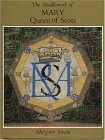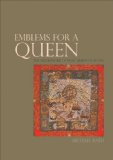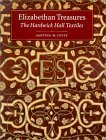






|
A webbed version of a handout from the "Design Your Own 'Oxburgh Hangings'" class taught at U. of A. LXIV. A version of this article appeared in Tournaments Illuminated #171. About the Oxburgh Hangings
Mary, Queen of Scots, spent about fifteen years (1569-1584) of her captivity under the custody of George Talbot, the Earl of Shrewsbury. Mary had learned embroidery during her childhood, in France; while she was a “guest” of Shrewsbury, she passed the time working on embroideries, sometimes in the company of the Earl’s wife, Elizabeth, Countess of Shrewsbury (also known as Bess of Hardwick). “This Queen continueth daily to resort to my wife’s chamber,” wrote the Earl, “where with the Lady Lewiston and Mrs. Seton she useth to sit working with the needle in which she much delighteth and in devising works” (Swain, 63). Visitors also noted her needlework: “I asked her Grace, since the weather had cut off all exercise abroad, how she passed the time within,” wrote Nicholas White, an envoy of Queen Elizabeth of England; “She said that all the day she wrought with her needle, and that the diversity of the colours made the work seem less tedious” (Swain 63). At some later point, the panels were mounted onto four "hangings," on green velvet; three of them (known as the Marian Hanging, the Cavendish Hanging, and the Shrewsbury Hanging, based on the central embroidery on each one) are presently on display at Oxburgh Hall in Norfolk, and the fourth has been cut up (some of the fragments are at the V&A or at the Palace of Holyroodhouse, and others were subsequently cut up for bed-hangings at Oxburgh Hall). Each of the hangings has a large square center panel, with an octagonal panel on each side, and surrounded with an evenly-spaced constellation of cruciform and octagonal panels. Each panel was professionally padded and mounted within a frame of damask or brocade, and outlined with cord. Swain argues that the mounting of the panels onto the Oxburgh Hangings took place well after the lifetimes of Elizabeth, George, and Mary, noting a reference in a 1586 inventory to a large number of uncut and unmounted embroideries (Swain 102). Levey, on the other hand, suggests that these are the "hangings of green velvet birds and fowls and needlework set upon the velvet" which were a point of argument between George and Elizabeth in 1584 (King & Levey, 18). In either case, it is certain that Elizabeth had many embroidered textiles made for her homes – including other cushion-covers by Mary – and certainly at no small expense. Designing your own panels in the style of the Oxburgh Hangings
Most of the panels are worked in cross stitch. As is visible in some of the panels in poorer states of repair, the outlines of the figures – many of which can be traced to woodcut illustrations in books of that time period (especially natural histories and emblem books) – were inked directly onto the surface of the cloth by a professional embroiderer hired for this purpose. Black cross stitches were worked directly over the outline, and then the figures were filled in from there (the designer may have also painted the colors for the background onto the cloth). Rather than inking directly onto fabric (since good needlework fabric costs a LOT more than paper), I tend to sketch patterns out on paper and/or use charting software. The two panels I've designed in this style started out with the octagonal template I'd counted out from original panels (click here for the templates; when mounted, the black outline tended to be covered up by the couched-cord border); the outlines for the lettering and figures were pencilled in lightly. Once I had the sketches spaced out to my satisfaction, I blacked in the squares through which the outlines travelled; I then copied them back into the design software, and reprinted a clean version of the chart. I then decided where the divisions between light and dark areas should go, sketching them in on paper, and fixed the curves and such, and then previewing them in the software. Once I had a chart I was happy with, I printed it out and worked the embroidery. Octagons: The octagonal panels are mostly either interlaced monograms or ciphers, or imprese. (See below for information about ciphers and imprese.) Mottoes or names fill the border; the writing starts at around the 9 o'clock point, going around counter-clockwise (the writing at the bottom is upside-down). Sometimes small designs fill the empty space – flowers at the corners of the borders, scrolling patterns filling empty space in the borders. At least one of the panels is based on a motto & illustration in an emblem-book. Cruciforms: The figures in the cruciform panels are generally animals – most of which come from woodcut illustrations in 16th century natural histories. The name of the animal – generally in English, though a few are in French or Scots – appears in one or more scrolls behind the animal. Instead of just a plain space between words, many have a dot – “A • FAVCONET •” or “A • BYRDE •” for example – though some have fancier dots (diamond shapes, a pattern of two or four dots, etc.) Writing: The writing in the borders of the octagons, and the scrolls in the cruciforms, are in blocky all-capital letters with serifs, not unlike an embroidered rendering of all-caps Times New Roman. Backgrounds: The backgrounds are filled in with either a landscape (watery waves for sea-creatures, green hills or plains and multi-hued skies for some outdoor animals and exterior scenes in imprese, and patterned floors and walls for other creatures) or, in the case of the monograms on some of the octagonal panels, a solid color. For more information
The most thorough book I can recommend on the subject of the Oxburgh Hangings is Margaret Swain's The Needlework of Mary Queen of Scots There are a few websites with color photographs of panels from the Oxburgh Hangings; the fragments at the V&A are visible at Search the Collections, and several of those attributed to Mary are online at www.marie-stuart.co.uk/embroidery.htm as well. Historians identify certain panels as having been worked by Mary, Queen of Scots, or Elizabeth, Countess of Shrewsbury, because some of them are signed with "ciphers" – a sort of monogram, but sometimes a more abstract design composed of initials. Some of the octagonal panels feature a cipher as the main figure, with an inscription worked all the way around the border; these are a sort of personal symbolism, and don't necessarily represent a worker's signature. One, for example, uses a cipher for ELIZABETH MARY – the names of the Queen of Scotland, and her cousin, the Queen of England – with the motto Virtutis vincula sanguinis arctoria (“The bonds of virtue are straiter than those of blood”); another uses a cipher for GEORGE ELIZABETH SHREWSBURY (that is, Elizabeth, Countess of Shrewsbury, and her fourth husband, George Talbot, Earl of Shrewsbury) with the words George Elizabeth Shrewesburye encircling the cipher, where Latin mottoes are found in most of the other octagonal panels; one for just George Shrewsbury appears on the Cavendish hanging, and one with just Elizabeth Shrewsbury appears on the Shrewsbury hanging. In the Cavendish Panel, comprised of mourning symbols for Elizabeth's second husband, Sir William Cavendish, the borders feature mirror-image interlaced initials ES (for Elizabeth) and WC (for William Cavendish). The following examples may inspire you to create your own ciphers for signing your needlework (or for use as “makers’ marks” in other art forms).
An impresa (pl.: imprese) is a sort of badge that is a combination of a motto and a picture; generally, they are read as a sort of fable or allegory, with the picture illustrating the story, and the motto (usually in Latin, or some other foreign language) as the moral. Several imprese appear in the octagonal panels of the Oxburgh hangings. The impresa of Mary’s mother, Marie de Guise – marigolds turning towards the sun -- is encircled by the motto Non inferiora secutus (“Not following lower things”). Another panel seems to have been inspired by the impresa on the Scottish “Mary Ryal” coin, which served as a metaphor for Mary’s marriage to second husband Henry Stewart, Lord Darnley; it features a tortoise (symbolizing Darnley) climbing a crowned palm tree (symbolizing Mary), with the motto Dat gloria vires (“Glory gives strength”). A thorough discussion of the impresa and its role in 16th century personal symbolism and artwork is beyond the scope of this class, but is undoubtedly valuable to those who wish to design panels in the style of the Oxburgh Hangings. However, here are some webpages which provide more information about imprese: Emblem-books of the time can be a valuable tool for reading up on the sort of iconography in an impresa. An emblem-book generally featured a collection of mottoes & proverbs with brief narratives (often in verse) and illustrations; some imprese borrowed from emblem-books, and vice-versa. (It’s not clear whether there was a distinction between an “emblem” and an “impresa” in 16th century western Europe – other than that the “impresa” usually referred to the shorthand form, with just the motto and picture.) Following are some useful webpages for learning about emblem-books, and viewing them online: |